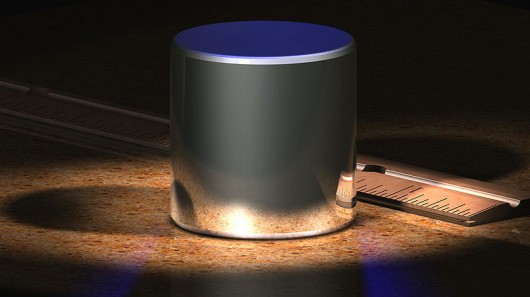Why the kilogram is getting heavier (and why a “sun tan” is the remedy)
January 7, 2013
According to researchers at Newcastle University in the United Kingdom, the kilogram is very likely getting heavier. How can this be? Mainly because we’re talking about the definitive kilogram, the International Prototype Kilogram (IPK) kept at the International Bureau of Weights and Measures in Paris. But because this is the kilo against which all kilos are defined, in a theoretical sense at least, all kilograms will technically be heavier too.
The IPK is a small cylinder of platinum-iridium alloy, about 39 mm (or an inch and a half) in both height and diameter. Using a unique Theta-probe XPS machine, Professor Peter Cumpson and Doctor Naoko Sano of Newcastle University have analyzed surfaces similar to those of the IPK to quantify the build-up of hydrocarbon contaminants. Their research indicates that the IPK is likely to have gained tens of micrograms in mass since the standard was introduced in 1875.
XPS stands for X-ray Photoelectron Spectroscopy, a process which involves irradiating a material with X-rays, and analyzing the quantity and energy of the electrons that are emitted, granting insights into the surface chemistry of the material, and the differences in it before and after some process (such as cleaning). What makes the researcher’s XPS machine unique is its argon cluster ion gun which emits charged clusters of argon, each containing around a thousand atoms. It’s this component that allows analysis of the organic layer – the gunk – without damaging the underlying inorganic material.
“It doesn’t really matter what it weighs as long as we are all working to the same exact standard – the problem is there are slight differences,” said Cumpson, in a press release put out by the University. “Around the world, the IPK and its 40 replicas are all growing at different rates, diverging from the original.” The 40 replicas Cumpson refers to were made in 1884, and distributed across the globe to help countries conform to the standard.
Though the tens of micrograms may sound insignificant, Cumpson claims any discrepancy between the IPK and its replicas could be problematic. “There are cases of international trade in high-value materials – or waste – where every last microgram must be accounted for,” Cumpson added.
However, the build-up of hydrocarbons can be removed with exposure to a mixture of ultraviolet light and ozone. “What we have done at Newcastle is effectively give these surfaces a suntan,” said Cumpson. “We can remove the carbonaceous contamination and potentially bring prototype kilograms back to their ideal weight, he added.” However, the real breakthrough is the quantifying of the build-up of contaminants through XPS analysis.
The kilogram is the only one of the seven base units of the the International System of Units (SI) to be derived from a physical artifact. The meter, for instance, is defined as distance traveled by light in a vacuum over the course of 1/299,792,458 of a second. Professor Cumpson and Doctor Sano's research may add further weight (if you'll pardon the phrase) to National Institute of Standards and Technology's 2010 proposal that the kilogram should be redefined with reference to the Planck constant.
Source: Newcastle University
Copyright © gizmag 2003 - 2012 To subscribe or visit go to: http://www.gizmag.com

